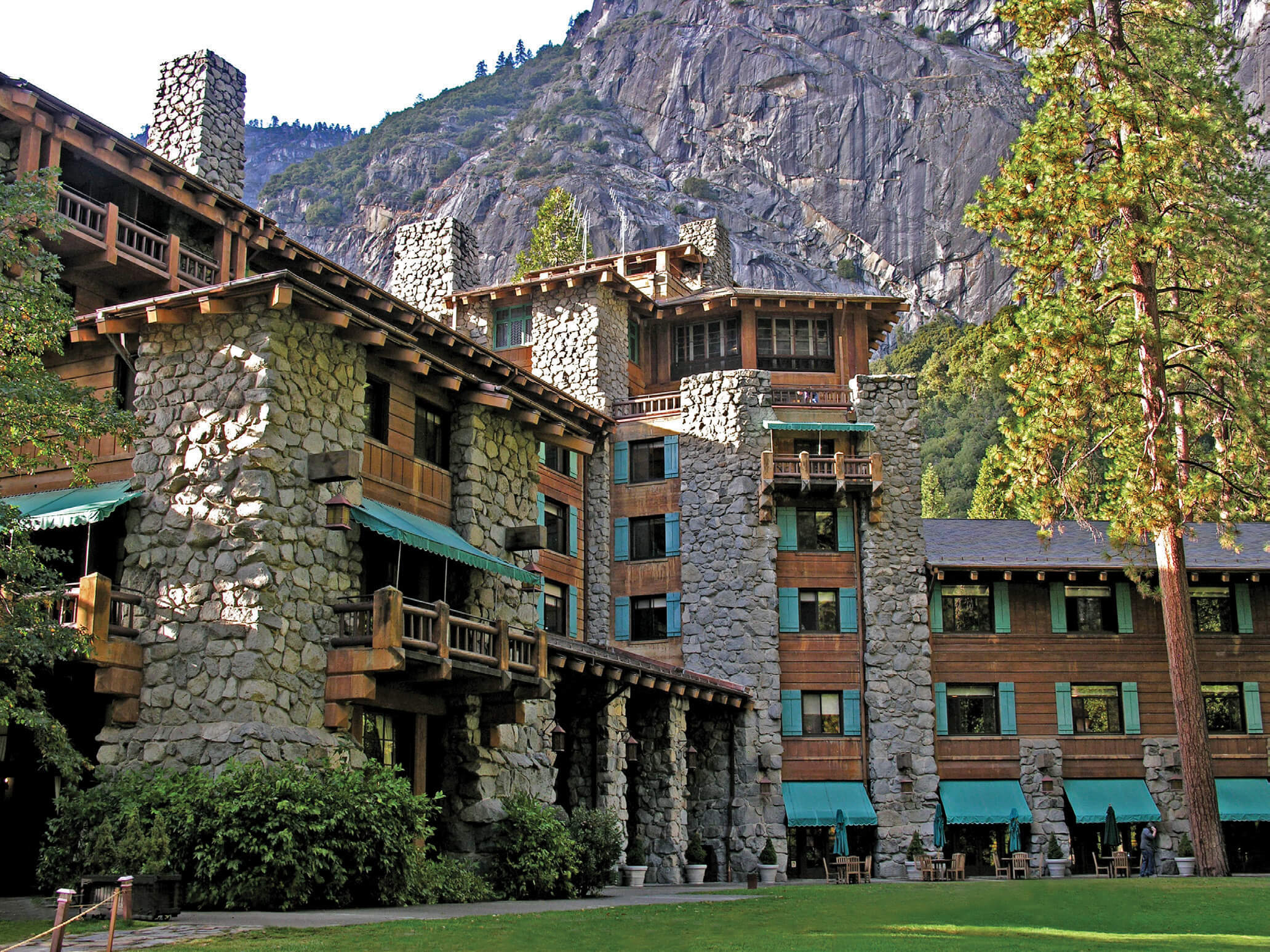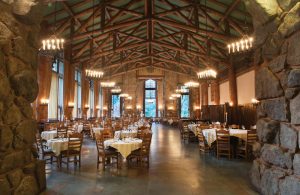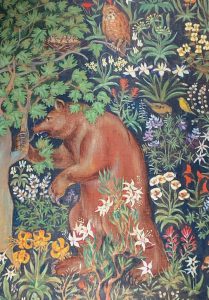
06 Jul Western Landmark: The Ahwahnee Hotel
In a meadow at the base of the Royal Arches in Yosemite National Park sits a landmark lodge that’s hosted the likes of John F. Kennedy, Eleanor Roosevelt, and Britain’s Queen Elizabeth and Prince Philip. The iconic Ahwahnee Hotel is located at the east end of Yosemite Valley, and even at 150,000 square feet, the building seems small compared to the north valley wall hovering behind it. The rough-cut granite and concrete exterior, stained and formed to resemble wood siding, camouflages the building within its natural surroundings.
The Ahwahnee Hotel was commissioned in 1926 by Stephen Mather, the first director of the National Park Service, to draw more affluent visitors to Yosemite. The construction was no easy task, requiring an estimated 5,000 tons of stone, 1,000 tons of steel, and 30,000 feet of lumber to be hauled into the remote location by truck — not to mention the kitchen equipment, furnishings, and decor. It was built in just under a year for $1.25 million and opened on July 16, 1927.

The 6,630-square-foot dining room feels even larger due to the 34-foot-high gable ceiling and floor-to-ceiling windows. Photos courtesy of the Ahwanee Hotel
The monumental structure is a prime example of national park-style architecture, or “Parkitecture,” that was taking off during that time. Although rustic on the exterior, the Ahwahnee’s opulent interiors set it apart as a luxury, upscale hotel that became known as the “crown jewel of Yosemite.” It is a must-see attraction that rivals the park’s many other points of interest, such as Bridalveil Fall and the granite cliffs of El Capitan and Half Dome.
While the hotel is a spectacular site, the significance of the structure runs much deeper. “The Ahwahnee is incredibly important not only to Yosemite’s history but also to National Park Service history,” says Yosemite’s public affairs officer Scott Gediman. “Many people don’t understand that this was the first federally designated land set aside for all the people; it was the birth of the national park concept.”
In 1864, during the Civil War, President Abraham Lincoln saw photographs of Yosemite’s dramatic landscape. He was urged by a California senator to designate it as the first reserve. It would take eight more years until Yellowstone National Park was founded in 1872, and by the time Yosemite was created in 1890, there was still no official agency managing these “protected” lands. “The concept of the national parks was, and still is, to preserve the lands for eternity, for all people, meaning no hunting or cutting trees,” Gediman says. “But since most of the population was still in the Eastern part of the country, no one was there to stop people.”
After East Coast millionaire Steven Mather visited Yosemite in 1914 and found it in poor shape, he wrote a letter to Secretary of the Interior Franklin Lane, explaining the need for a government agency to manage these reserves. The response? To come to Washington, D.C., and set it up himself. In 1916, Mather became the first director of the National Park Service. “He was such a visionary, but there was still no budget,” Gediman says. “That’s when he suggested a luxury hotel, so people of wealth could visit and be more inclined to support the park service. The Ahwahnee is so symbolic of the concept that the National Park Service needed support, not just from visitors, but also from government officials.”
The Ahwahnee’s interiors — an elegant and eclectic blend of American Indian, Craftsman, and Art Deco styles — serve as a sharp contrast to the wild lands that sit just outside. Throughout the hotel, decorative tile adorns the floor with colorful patterns. Wrought-iron chandeliers and grand fireplaces bring warmth to the cavernous spaces. On the south end, the Great Lounge consists of intimate seating areas with original furnishings, floor-to-ceiling windows with stained glass panels, and Persian rug wall hangings. A solarium opens to views of the lush meadow. On the hotel’s first floor, the Mural Room is an artful setting to retreat after a hike or to enjoy a glass of wine. The large mural by Robert Boardman Howard depicts the park’s native flora and wildlife; the more you look, the more you uncover. And in the Winter Club Room, memorabilia and information provide the history of winter sports in the park.

A detail of Robert Boardman Howard’s mural in the Ahwahnee’s Mural Room. It serves as both decor and a natural guide to Yosemite. Photo: Norman Kolpas
Many come to the hotel to enjoy breakfast, lunch, or dinner in the Ahwahnee Dining Room. The 6,630-square-foot space features a 34-foot-high gabled ceiling, pine trusses, exposed stone walls, floor-to-ceiling windows, chandeliers, and the original tables and chairs. With a celebrated Sunday brunch and American fare for dinner — think prime rib, salmon, and lamb — a dress code remains in place. “For dinner, they used to require jackets,” Gediman says. “That’s evolved into asking men to wear collared shirts and, in general, to just be more classy. The ambiance is meant to be elegant and stately, but not pretentious.”
The Ahwahnee’s 97 rooms and 24 guest cabins — looking out to either Yosemite Falls, the Royal Arches, Glacier Point, or Half Dome — are designed to reflect the natural surroundings. Averaging $500 per night, an overnight stay is not in everyone’s price range, but the public spaces of this National Historic Landmark can be explored and enjoyed by all curious visitors.
“That’s the concept: that the wealthy can stay in the rooms, but others can still enjoy it,” says Gediman. “The Dining Room and Great Lounge were specifically designed to welcome visitors, even if they weren’t staying there. It adds to people’s love of Yosemite … Mather was a genius.”






No Comments